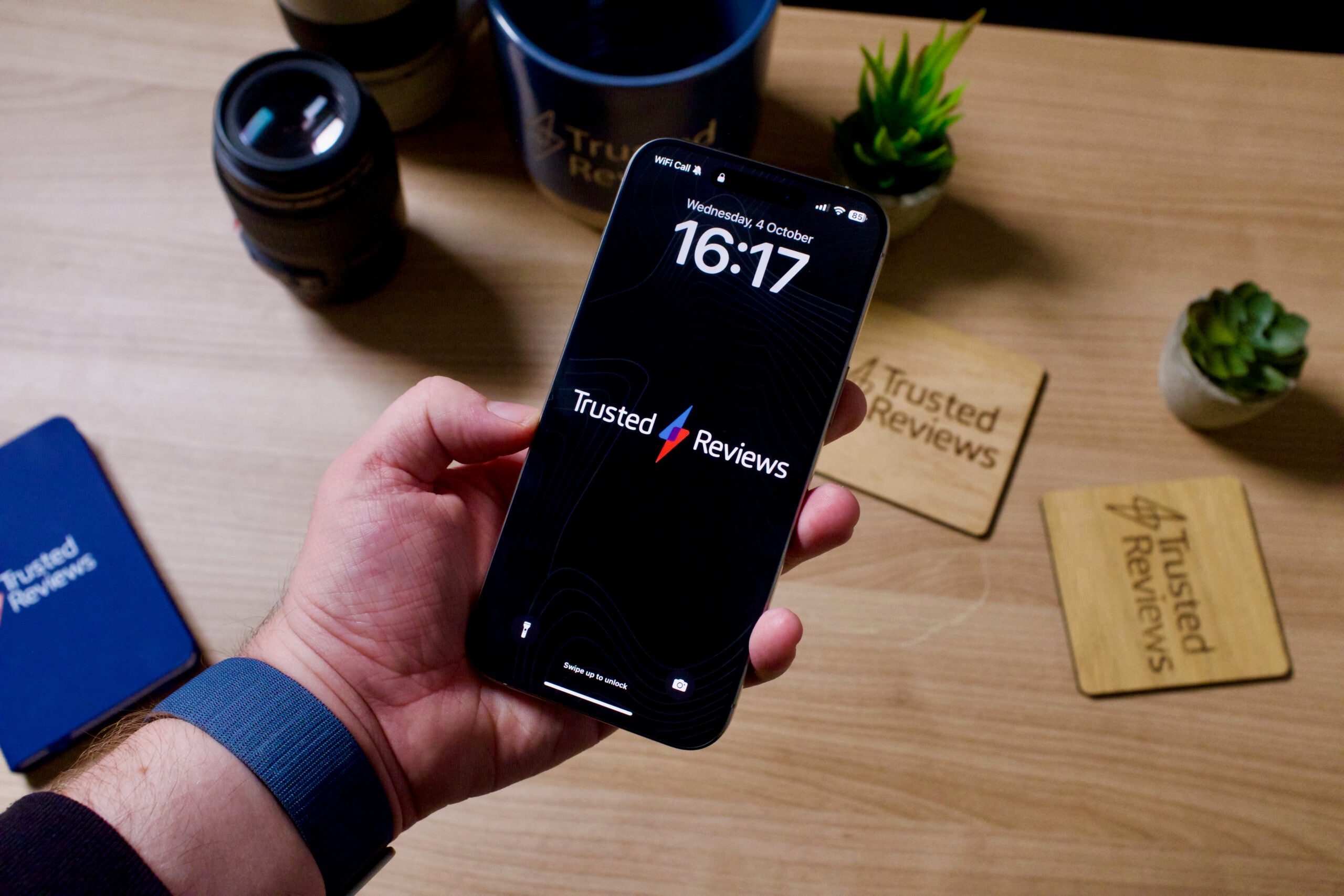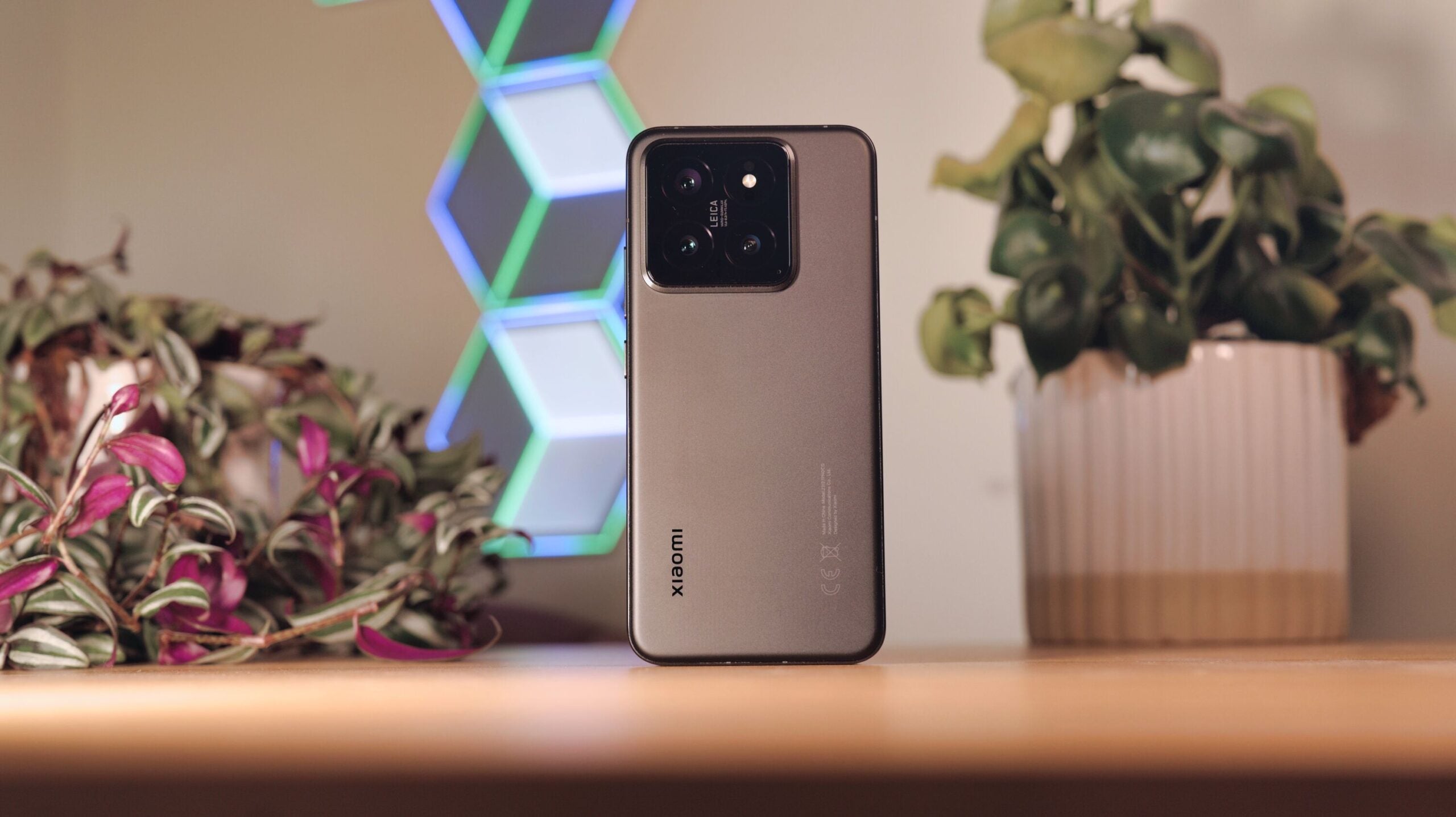Asus ROG Phone 7 Ultimate Review
The ultimate gaming phone


Verdict
The Asus ROG Phone 7 Ultimate is a beast of a gaming phone, with rapid performance, booming speakers and cutting-edge features. But while this is an excellent phone in its own right, I’m not convinced there’s enough of an upgrade to justify the extra cost compared to the standard Asus ROG Phone 7.
Pros
- Elite performance
- Mammoth battery life
- Loud and booming speakers
- AirTriggers improve gaming controls
Cons
- Very expensive
- Too similar to ROG Phone 7
Availability
- UKRRP: £1199.99
Key Features
- Powerful performance:The Snapdragon 8 Gen 2 processor ensures this is one of the fastest Android phones that you can buy.
- ROG Vision animation screen:The ROG Vision is a secondary screen, found on the rear, which can alert you to notifications or provide the phone’s charging status.
- Massive battery:The 6000mAh battery enables the phone to last for nearly two days on a single charge. Fast charging is also supported.
Introduction
Asus is hoping to position the ROG Phone 7 Ultimate as the very best gaming phone on the market, packing the fastest possible chip as well as a slew of features to sate even the most obsessive of gamers.
The Asus ROG Phone 7 Ultimate differentiates itself from the standard ROG Phone 7 with a notification screen panel on the rear and enhanced cooling courtesy of the AeroActive Portal – those extra features will cost you an additional £200 ($TBA) compared to the vanilla edition, taking the price up to £1199.99.
Otherwise, the specs and features are the same (even the Snapdragon 8 Gen 2 chip) so you’ll have to decide whether those extra features justify the inflated cost. I’ve spent a couple of weeks with the Asus ROG Phone Ultimate 7, so here are my thoughts.
Design and Screen
- Huge 6.78-inch AMOLED screen
- ROG Vision screen on the rear
- AirTriggers are handy for gamers
The Asus ROG Phone 7 Ultimate is a gigantic phone, with Asus opting for a huge 6.78-inch AMOLED screen to maximise your gaming experience. And despite the Samsung Galaxy S23 Ultra having a marginally larger screen, the ROG Phone 7 Ultimate is still noticeably taller due to the bezels at both the top and bottom – Asus doesn’t want a punch-hole camera getting in the way of your games.
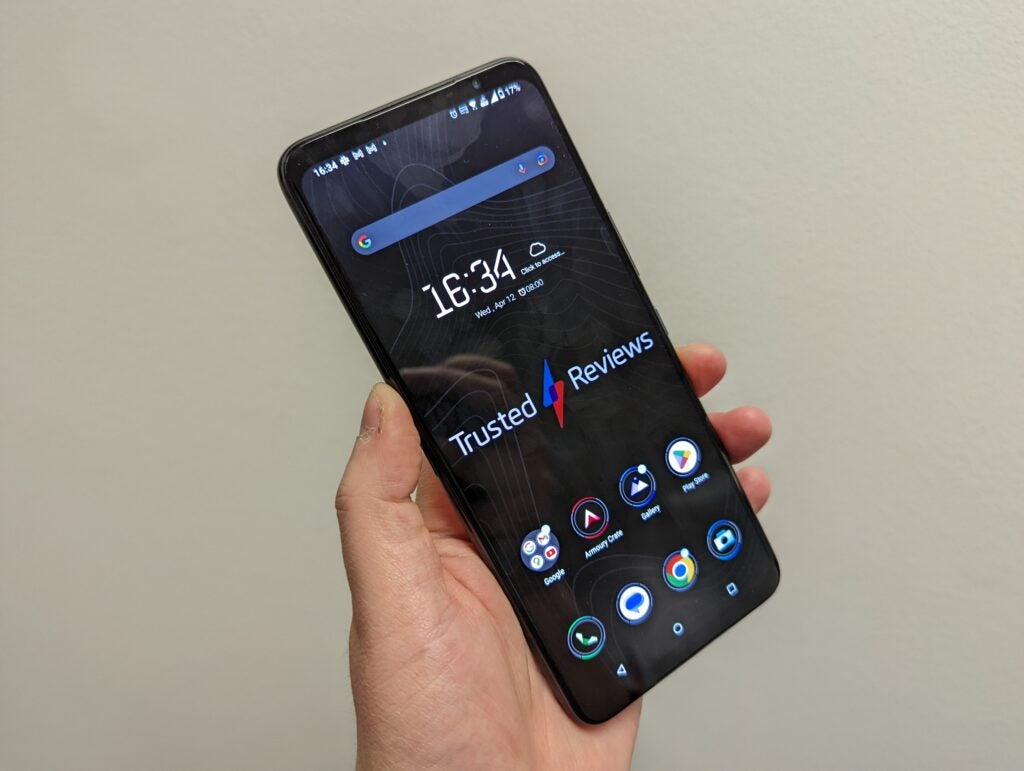
As someone with small hands, I did sometimes struggle to type messages one-handed, but it was still easy enough to slip into a pocket despite being one of the chunkier phones (1.4mm) I’ve used in recent years.
I found the phone’s appearance to be a greater concern, with the sci-fi aesthetic and emblazoned logos that highlight the phone’s gaming heritage making it a little embarrassing to use in public. You only get the option of the Storm White coloured rear with the Ultimate, which is a pity since the standard ROG Phone 7 is also available in Phantom Black, which I think looks nicer and less imposing.
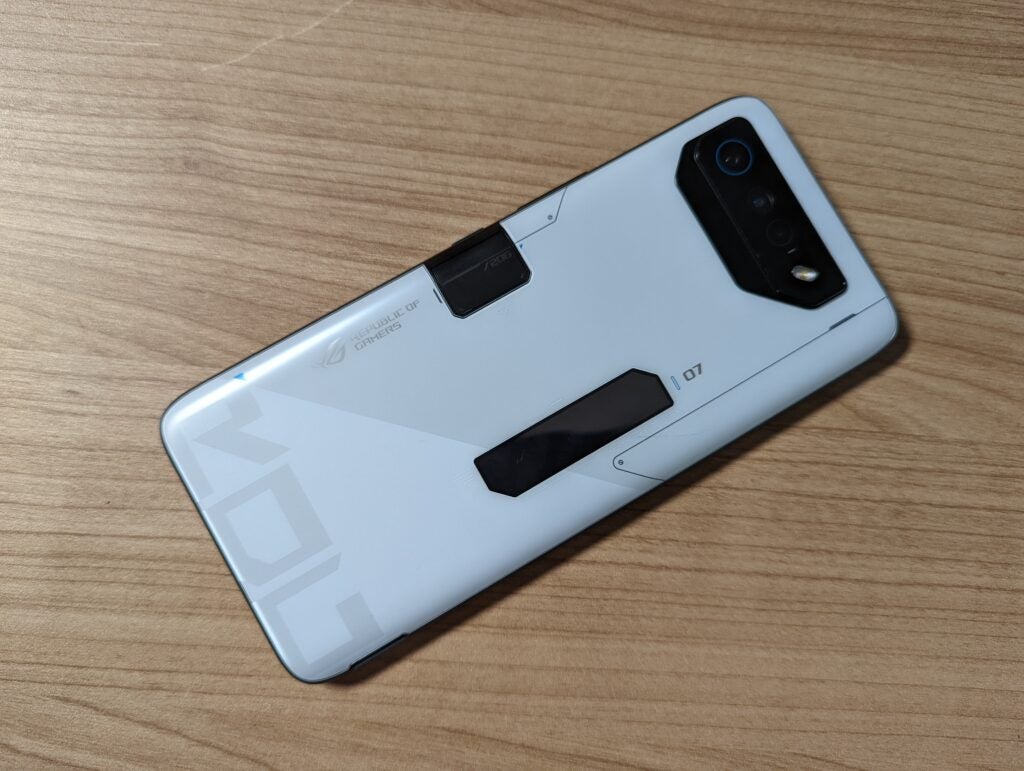
The ROG Phone 7 Ultimate even has a screen panel on the rear called the ROG Vision, which can be configured to show a variety of animations once triggered. There’s the default ROG logo when you wake up your phone, a charging status, incoming call alert and a notification bar, among others.
I’m personally not too enamoured by this feature, especially since the always-on display provides the same useful information following a tap. It’s a shame you can’t customise the panel with your own text or pixel art, like you can with the ROG Zephyrus G14 laptop, as that would make the upgrade more tempting.
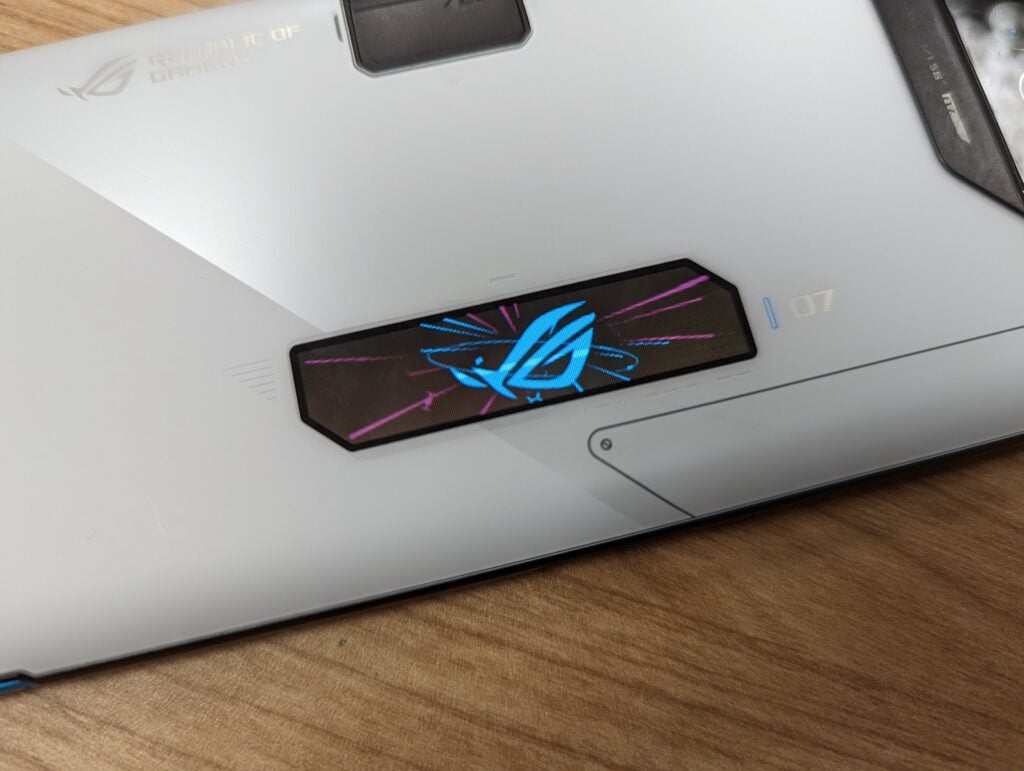
The Ultimate has another exclusive feature in the form of the AeroActive Portal, which is a panel of the back that automatically opens to improve airflow whenever it detects high internal temperatures. It’s a nice added feature, especially when I found how hot the phone becomes during stress testing, with Asus claiming it to boost thermal efficiency by 20%. But is it enough to justify the upgrade to the Ultimate edition of this phone? Probably not.
Asus has made other improvements to the cooling too, with a new rapid-cycle vapour chamber. When playing an hour’s worth of Call of Duty Mobile, I never found the phone to become concerningly hot, but it still feels like a frivolous feature when phones such as the Samsung Galaxy S23 are capable of similar gaming performance.
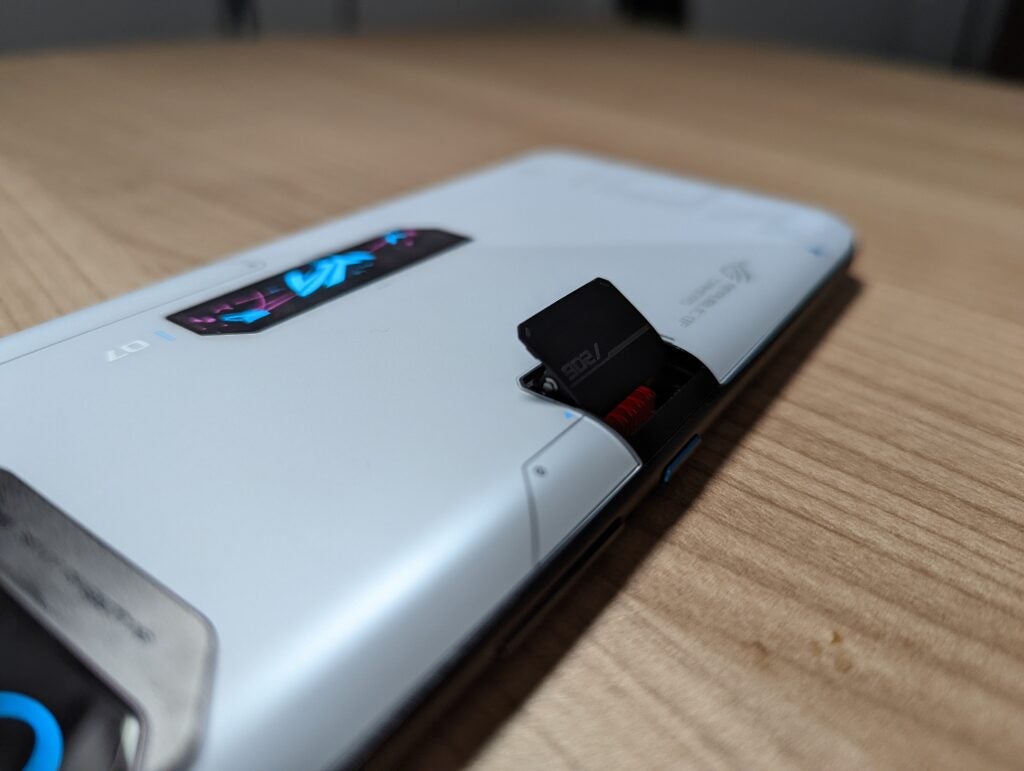
My favourite feature on the ROG Phone 7 Ultimate is the addition of the AirTrigger haptic controls. These allow you to map in-game inputs to the phone’s virtual triggers, replicating the feel of using a traditional gamepad. In Call of Duty Mobile I configured the right trigger to shoot, and left to crouch, and it improved the ergonomics to such an extent that I felt like I had an unfair advantage.
The vibrations of the haptic feedback are pleasingly strong, and it never felt odd to be squeezing down on solid metal rather than a mechanical trigger. Don’t get me wrong, I still prefer having physical triggers from the likes of the Razer Kishi mobile controllers, but Asus still offers a superb alternative to those who don’t fancy lugging around extra accessories. The AirTriggers debuted on the Asus ROG Phone 5, so are hardly new for the 7 Series. But they remain a good incentive to buy a ROG Phone over any non-gaming phone.
You’ll find two USB-C ports on this phone – one in the conventical bottom position, and another on the right-hand side. There are a number of reasons for this: firstly, it allows you to charge your phone while holding in a horizontal position for gaming, and secondly it ensures you can plug in external accessories (such as the AeroActive Cooler) without preventing you from charging the phone simultaneously.
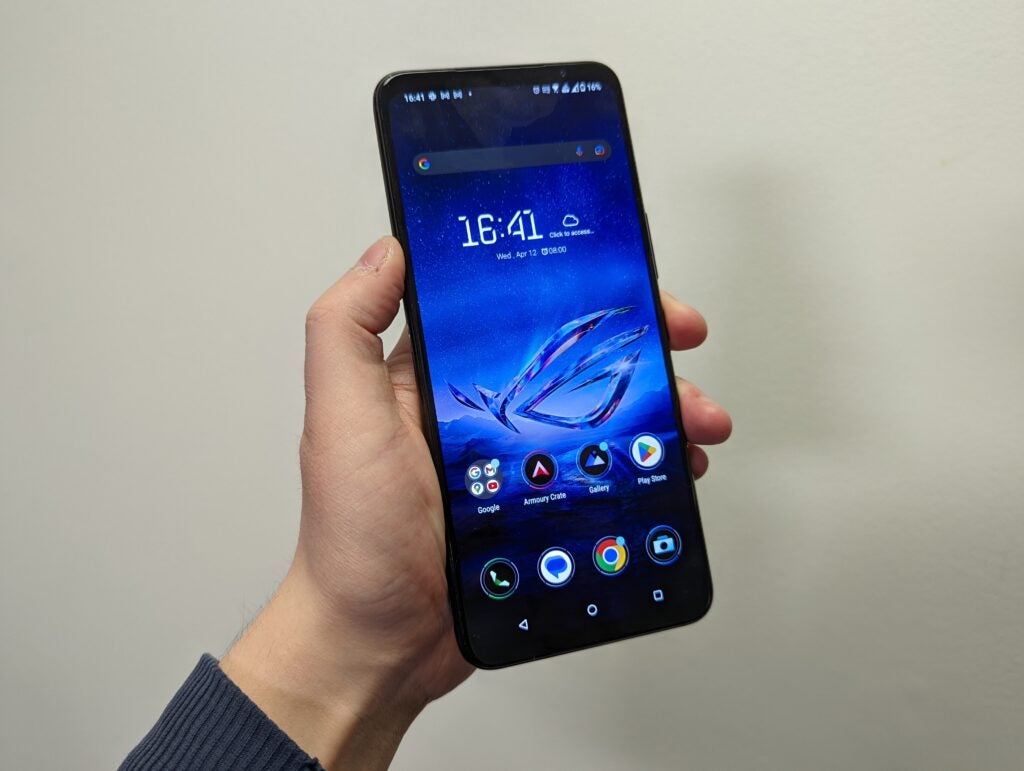
The AMOLED screen is bright, punchy and vivid. Asus claims a peak brightness of 1500 nits, which I found to help ensure the display is visible even with bright sunlight. The phone also supposedly covers 150.89% of the sRGB gamut, ensuring accurate colours for games and videos. I was impressed with the screen’s performance, proving highly competent at presenting the bright flash of a grenade as well as the detailed design of my in-game rifle.
Asus has also included a volume switcher, standby button and headphone jack. There’s also support for Bluetooth 5.3 and Wi-Fi 7 to ensure cutting-edge connectivity. The ROG Phone 7 Ultimate has an IP54 rating, which means it can handle the odd splash of water, but it isn’t waterproof, so avoid dunking it in the pool.
Asus has stuck with a 2448 x 1080 resolution, reluctant to jump up to QHD+ like the Samsung Galaxy S23 Ultra. That may be a shame for those who want the most detailed possible picture, but I think it’s a smart move to ensure you’re getting the best battery life possible. You also get a 165Hz refresh rate, allowing you to make the most of the new 120Hz mode on Call of Duty Mobile – although there’s still not enough mobile games that support the high refresh rate for my liking.
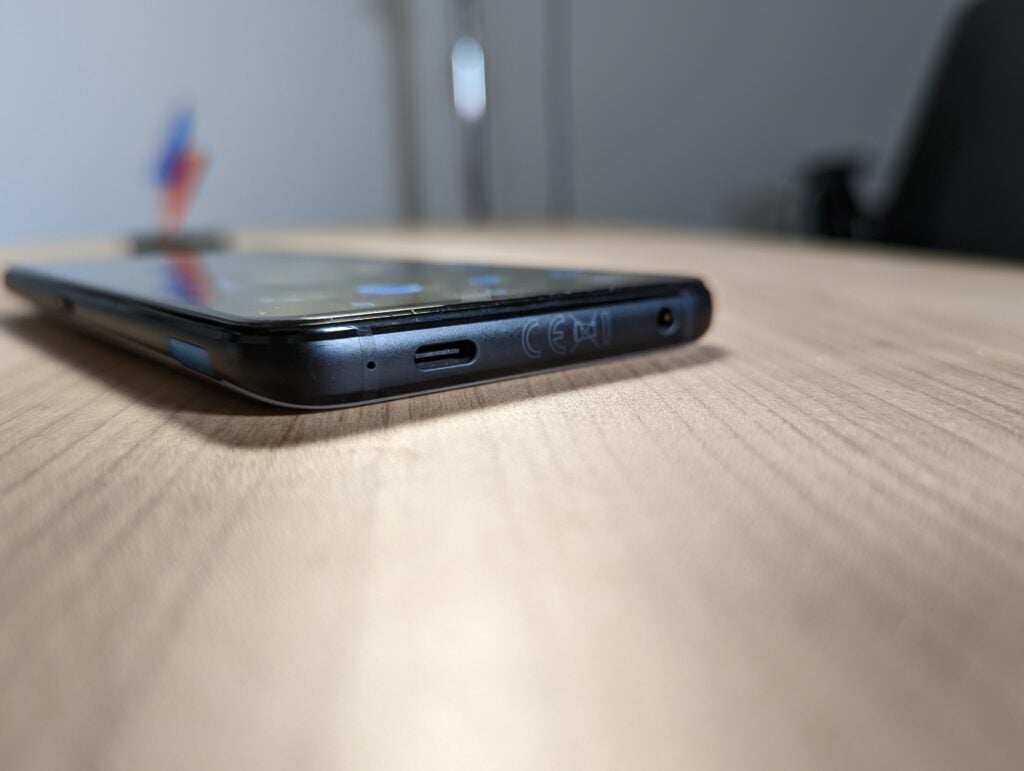
The high 720Hz touch-sampling rate ensures touchscreen prods and swipes will be registered at lightning speeds, which is highly important for mobile games that rely on quick reactions.
The front-firing twin speakers are one of the most impressive aspects of this phone, offering 50% more volume than its predecessor. I was really impressed by the weighty sound and heavy bass, presenting the thundering noise of gunfire expertly well.
Audio from my Google Pixel 6 sounds flat in comparison, and can sound a little screechy with music playback. I’d happily use the ROG Phone 7 as an alternative to a speaker at home, with enough volume to fill a room and high enough audio quality that I’m not itching to plug in my headphones. The Asus ROG Phone 7 Ultimate has the best speakers I’ve heard from any smartphone yet.
Camera
- 50MP main sensor
- 13MP ultra wide and 5MP Macro
- 32MP selfie camera
With gaming phone manufacturers so keen to maximise performance and add in oodles of features, there needs to be at least one area where they’ll cut corners – that’s usually the camera, and the Asus ROG Phone 7 Ultimate does not buck this trend.
Asus has implemented the extra same trio of cameras on the rear as the preceding Asus ROG Phone 6 Pro and Asus ROG Phone 6D Ultimate. This includes a 50MP main sensor, 13MP ultra wide and 5MP Macro. That doesn’t mean the snapping quality will be the exact same though, as the new Snapdragon chip helps to improve image processing.
The 50MP main sensor can’t compete with most phones at a similar price (particularly the Galaxy S23 Ultra with its 200MP sensor) but it’s still reasonably competent at standard snaps. It can capture bold and bright colours as shown with the graffiti below, which looks pleasing to the eye.

The camera starts to sour when you make use of the other two sensors. The 13MP ultra wide camera allows you to capture a wider portion of the scene, but at a great cost to the detail.
If you check out the comparison images below, you’ll notice that a lot of detail has been lost by swapping to the ultra wide lens. For example, the brickwork becomes blurrier and the aerials on the roof look far more indistinct, fading into the background.


I also wasn’t too impressed with the 2x zoom feature when comparing it to my Google Pixel 6, which is a considerably cheaper phone. The blue sky appears muted with the ROG Phone, while you can also see a loss of detail in the likes of the red brick wall and the clouds. It’s still a reasonable picture, but you can get better quality with a cheaper phone.

There’s no surprise that the 5MP macro camera fails to impress too. This close-up shot of a flower doesn’t pack quite enough detail to compete with other flagship phones that cost over £1000/$1000. And once again, colours appear muted and dull.

I’m pleased with the photos taken with the 32MP selfie camera. Skin tones look natural, while imagery looks sharp, both for the subject and background.

The camera is undeniably the weak point for the Asus ROG Phone 7 Ultimate – as it is with most gaming phones – lacking the versatility of flagship phones such as the iPhone 14 Pro Max and Samsung Galaxy S23 Ultra. But it’s still capable of good looking snaps, just as long as you stick to the basics.
Performance
- Powered by the Snapdragon 8 Gen 2
- 16GB of RAM and 512GB storage
- Superb thermal performance
The Asus ROG Phone 7 is powered by one of the most powerful chips currently available for an Android handset: the Snapdragon 8 Gen 2. This is an octa-core processor with frequency speeds peaking at 3.2GHz. The Samsung Galaxy S23 phones are the only Androids that can boast better performance, powered by an overclocked version of the same chip.
Thanks to this overclocked chip, the Galaxy S23 is able to match the Asus ROG Phone 7 Ultimate in our graphics benchmarks, suggesting it’s equally just as good when it comes to gaming performance, despite Asus fitting in an elaborate cooling system.
That said, the cooling system does enable the ROG Phone 7 Ultimate to maintain that high performance over long stretches of times. In the 3DMark Wildlife Extreme Stress Test, the Ultimate saw results fluctuate between 3650 and 3729. The Galaxy S23 managed to see an even higher peak score of 3771, but also dropped down as low as 2297, indicating its thermal performance isn’t quite as good as the latest ROG Phone.
The Asus ROG Phone 7 posted an elite graphics benchmark score, and the greatest Geekbench 6 score we’ve seen yet – this phone is seriously speedy.
When compared to its predecessor, the ROG Phone 6D Ultimate, there’s a significant boost to performance, most noticeably with the game benchmarks – a 26fps increase for GFXBench Aztec Ruins and 30fps jump for GFXBench Car Chase. In terms of real-time gaming, I was also able to run Call of Duty Mobile at the max 120fps setting, resulting in a stable and smooth performance.
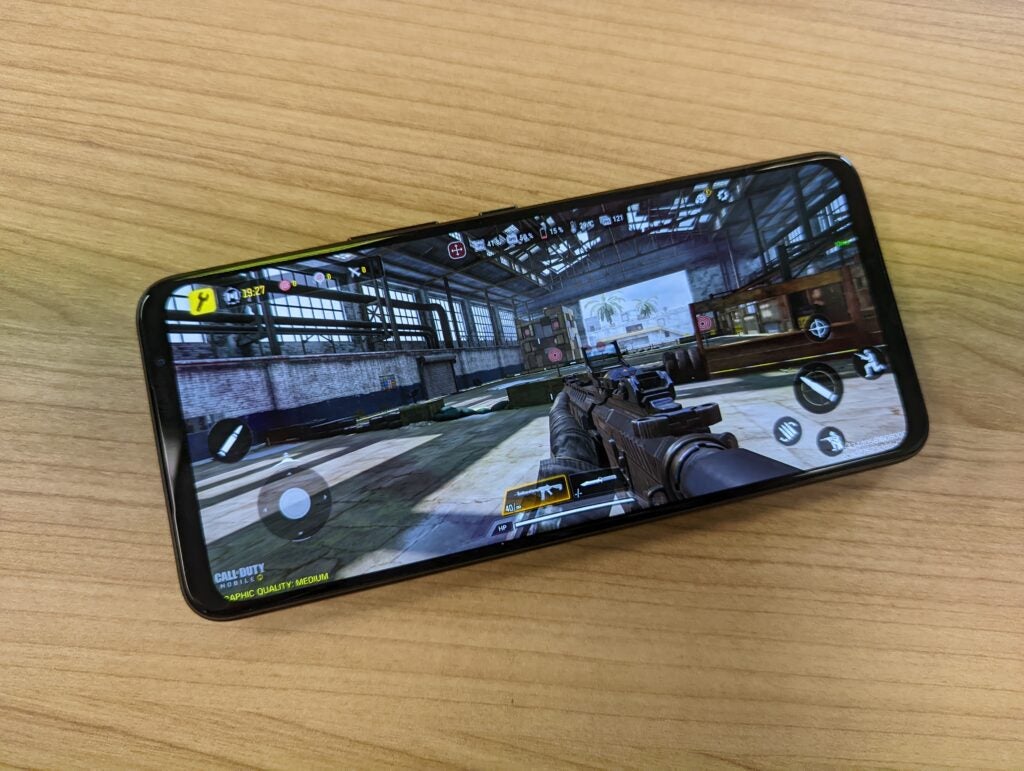
The Asus ROG Phone 7 Ultimate did warm up a bit while playing Call of Duty Mobile, but not enough to ever become uncomfortable to hold. But when stress testing the gaming phone via 3DMark, it became scorching hot. That shows it is possible to overheat this phone if pushed far enough. I’m not convinced there are many games that can push the ROG Phone 7 that far, but you do have the option of the AeroActive Cooler 7 accessory if you happen to play particularly demanding games.
You’ll get the same specs whether you opt for the ROG Phone 7 or ROG Phone 7 Ultimate. Asus has packed both phones with 16GB RAM and 512GB storage. Call of Duty Mobile is the largest game in terms of file size I have installed on the phone, and that only takes up 6.27GB, so I don’t think many people will be clamouring for a 1TB upgrade.
Battery life
- Massive 6000mAh battery
- Not far from two-day battery life
- Can be fully recharged in 40 minutes
Asus has slapped a massive 6000mAh battery inside the ROG Phone 7 Ultimate, which is an even bigger capacity than the cell inside the Galaxy S23 Ultra.
I’m really impressed with this phone’s stamina, comfortably outlasting the day and not too far away from overcoming a second. After charging the phone overnight and unplugging at 8am, it only fell down to 54% when it was time to sleep at 11pm. That involved a typical work day, including an hour’s worth of Netflix, a couple of hours of Candy Crush, as well as lots and lots of idle scrolling through social media. It took until 7pm the following day for the battery to completely drain.
To break it down even further, one hour of Netflix took off 7% of battery life, while playing Candy Crush for 30 minutes only depleted the cell by 3% – that latter result is the best we’ve seen in recent months, beating even the Samsung Galaxy S23 Ultra.
Playing a more demanding game such as Call of Duty Mobile will deplete the battery at a quicker rate. The battery dropped by 13% within an hour. Some quick calculations suggest you’ll be able to keep on gaming for seven and a half hours before the phone runs out of juice.
Charging is pleasingly rapid too thanks to the bundled 65W HyperCharge adapter. It took just 40 minutes for the phone’s battery to be fully replenished, with 15 minutes of charging time seeing the battery recharged by an impressive 46%. That’s remarkable considering how big the battery capacity is here.
I’m a big fan of some of the battery care features included with this phone too. You’re able to activate Steady Charging which slows the pace of charging to prevent you burning out the battery. And you can even set your own scheduled charging time or set a charging limit. These are all very clever methods of keeping your battery in good shape over time.
Latest deals
Should you buy it?
You want the ultimate gaming phone: Ignoring price, this is the absolute best gaming phone you can buy. Performance is excellent and is jam-packed with useful features.
You don’t care about the extra features: The only upgrades you get with the ROG Phone 7 Ultimate compared to the more affordable ROG Phone 7 are an animation panel on the back and improved cooling.
Final Thoughts
The Asus ROG Phone 7 Ultimate is a superb gaming phone. It’s one of the most powerful Android handsets you can buy, has room-filling bassy speakers and a suite of features to improve portable gaming, including the AirTriggers which is a massive improvement on the touchscreen controls.
You will need to compromise on the camera quality here though, with the likes of the Samsung Galaxy S23 Ultra and iPhone 14 Pro Max offering a great deal more versatility for the steep price.
The biggest issue here, however, is that the extra features (namely the animation screen panel and enhanced cooling) provided by the Ultimate edition arguably don’t justify the inflated cost. With the exact same specs found on both of the latest ROG models, I’d recommend sticking with the more affordable Asus ROG Phone 7 instead if you’re not fussed about frivolous features.
How we test
We test every mobile phone we review thoroughly. We use industry standard tests to compare features properly and we use the phone as our main device over the review period. We’ll always tell you what we find and we never, ever, accept money to review a product.
Used as our main handset during test period
Camera tested in variety of situations with all modes
Tested with synthetic benchmarks and real world use
FAQs
The Asus ROG Phone 7 Ultimate reviewed here is the most expensive ROG phone you can buy.
The Asus ROG Phone 7 Ultimate offers a greater number of features, but the ROG Phone 7 is largely the same but available at a more affordable price.





